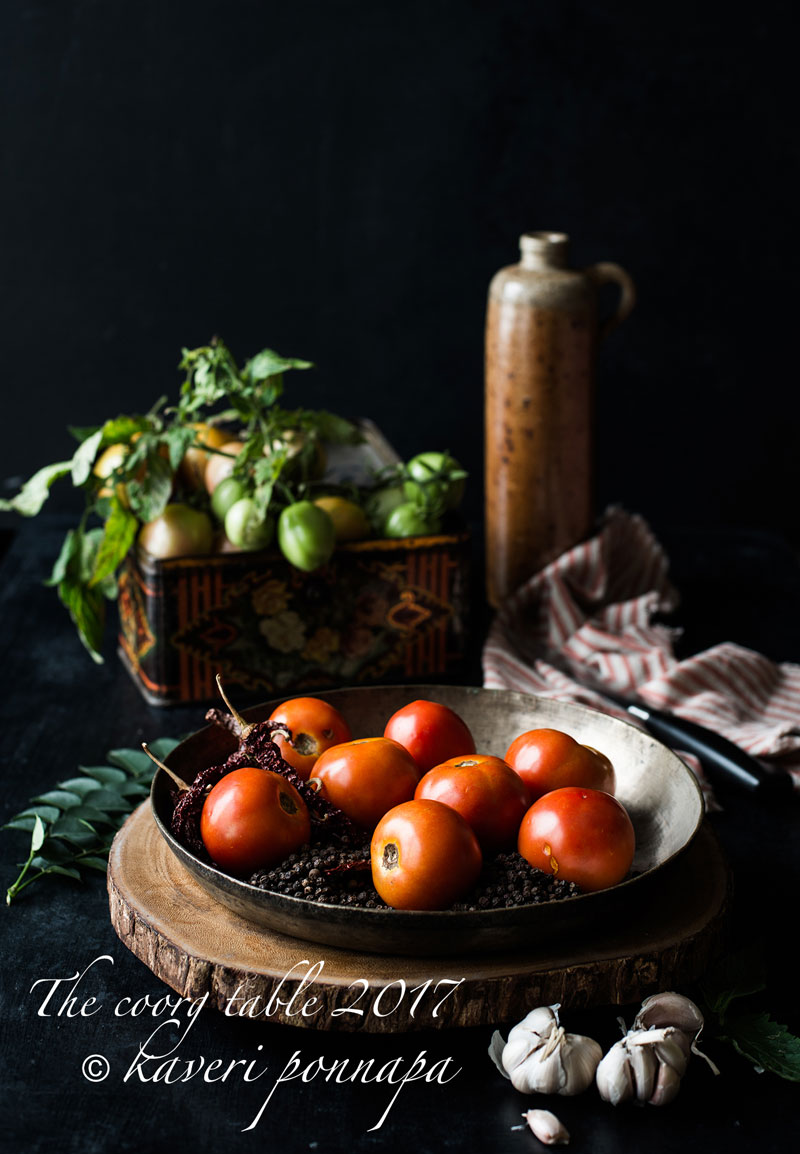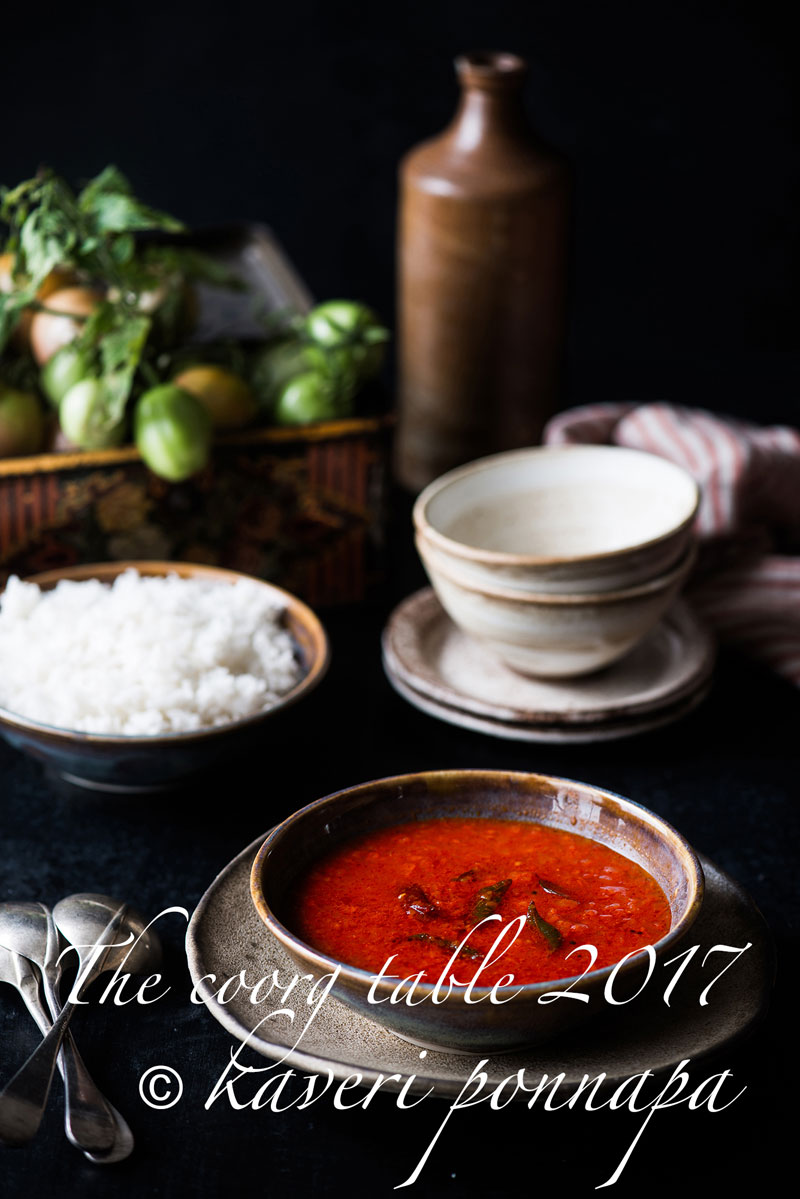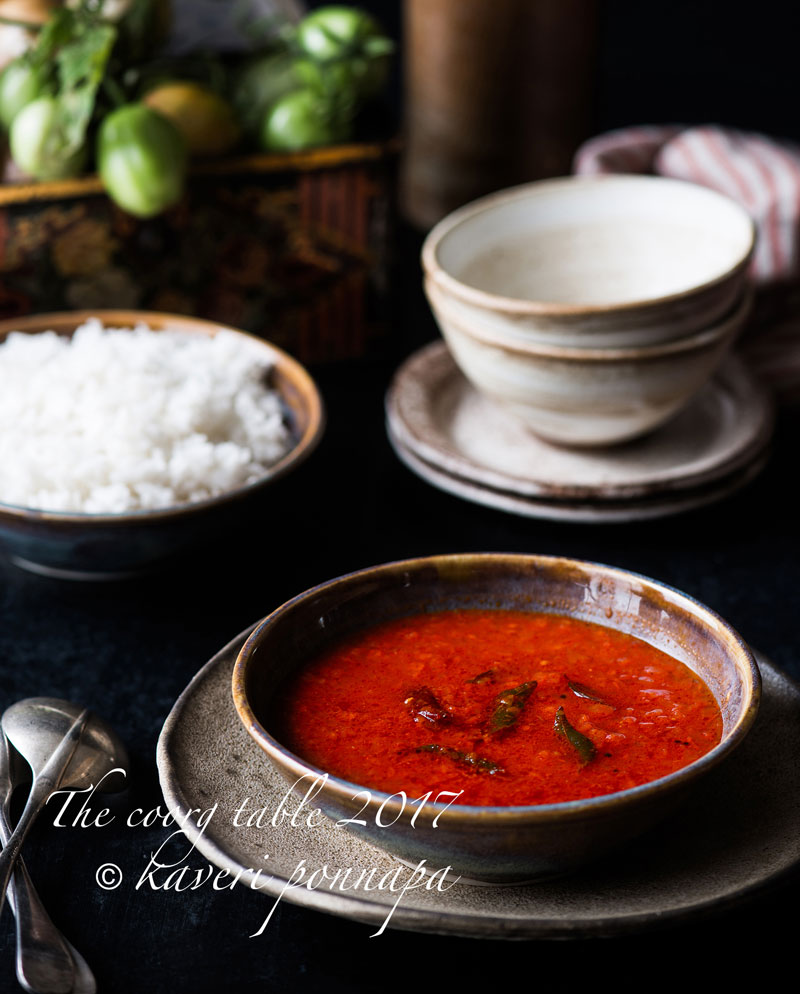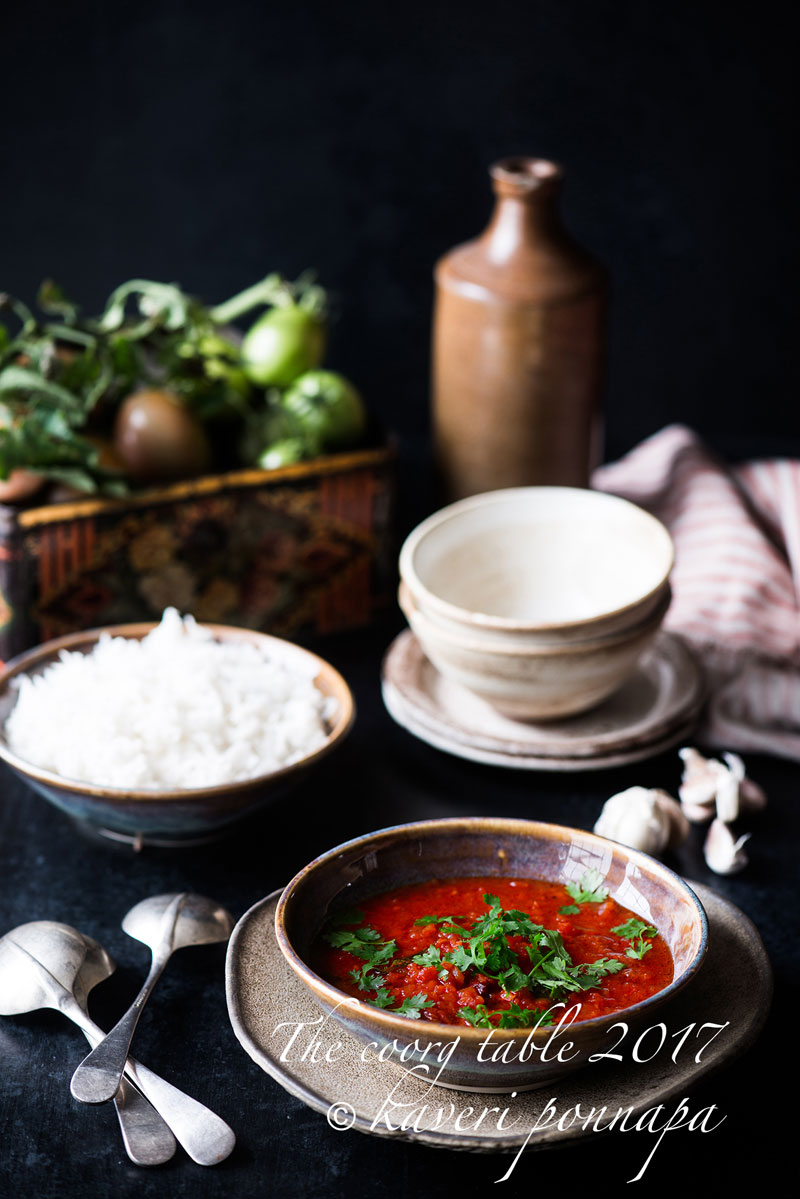From the shores of the Arabian Sea and the coast of Malabar, vibrant with a spice trade that lured Greeks, Romans and Arabs to navigate uncharted seas over the millennia, it’s an uphill trek into the forests of Coorg. In the days when the caravans described in our folk songs rolled out of the grand old houses and wound their way down to the coast to trade rice for oil, salt and more, pepper was already growing wild in the (then) dense forests; cardamom, warm, sweet, aromatic, grown on hills leased by the kings of Coorg was a familiar and much-loved spice. Coriander, nutty and citrusy, had made its journey from the eastern Mediterranean, and fenugreek, sharp, bitter, but capable of sweetness, another traveller, was long established. Wild Cinnamon, with its strikingly coloured pink leaves, grew on the hillsides. Along with just a few other ingredients, they formed part of a spare palette of roasted and ground spices that went into Coorg cuisine. Black peppercorns, known as ‘kartha paun’, meaning black gold –the same name by which it was referred to in medieval Europe –was always a precious spice in Coorg. It dominates our spice mixes, used in innumerable ways in almost every dish, valued for its slow, smoldering heat. We would have to wait several centuries for Portuguese explorers and conquerors to land on these same shores, in search of pepper, to bring us the fire of the tiny chillies we still refer to as paringe, or ‘firangi’, acknowledging its unfamiliar origins.

The turbulent spice trade, in the wake of which, John Keay wrote, “… atrocities would be freely committed, wars fitfully fought, states toppled, peoples uprooted, hundreds of ships lost, thousands of lives squandered –and all for…various desiccated barks, shrivelled berries, knobbly roots, dead buds…” that shaped the lives of our nearest Malabar neighbours, Kannur and Kozhikode, “the great country of the Western Ocean”, largely passed our tiny, landlocked country by.
Over the exuberant cosmopolitanism of open cities at the ocean’s edge, we chose tangled paths of forest that keep their secrets, where hills divided and demarcated a small land made vast by its geography and, in small pockets, local cuisine and spice blends developed at their own pace, individual character stamped upon them.
Boji lives in a particularly tranquil and isolated part of Coorg. For generations, it was practically another world, known for the generosity of its rice fields, wide meadows, an abundance of rainfall which often left people marooned in their homes during the monsoons. The same waters often cut off villages from the rest of Coorg, making the area seem even more remote in the imagination than it was. Homes here are set far apart; the expanses of sky and space seems endless, even some of the vocabulary and the inflexions of language are different. And yet, it is Coorg, and as the crow flies, not far from the teeming ports of the Malabar Coast that once commanded the spice trade.

Boji cooks and gardens, spending most of her time in the kitchen, devoting herself to traditional Coorg fare. Her particular spice blend has her family –and now us –in its thrall. The mixture is deceptively simple. Just one ingredient in minuscule quantities differentiates it from the other combinations gathered from many home cooks I have scribbled down on scraps of paper – Marathi moggu: Indian capers, or kapok buds. The quantity used is so small, the change in flavour seems a sleight of hand. The results, though, are extraordinary. The first time I roasted and powdered a quantity of Boji’s masala, my husband, who was passing by the kitchen, stopped to ask what I was making, and breathed in the aromas wafting out of the jar I had just filled. I used it to make a slow cooked gravy of tomatoes finished with quantities of fresh coriander leaves. The pepper suffused tomato kanni was swiftly consumed between just the two of us, my husband and I, and we scraped our plates clean. I mulled over the intriguing flavours, trying to understand them –a slight, tantalizingly unfamiliar pungency that transformed the dish.

The lovely young woman who gave me the recipe for her mother’s spice mix and tomato curry tells me how her father feels a meal is never complete until he has eaten a little bit of this refreshing curry. And also, how it was such a part of their childhood that her brother and she would make wicked jokes about the frequency with which it turned up on their table! But now they crave it. Boji makes her special masala in enormous quantities and stores it. It forms the bedrock of most of her cooking, adding its particular flavour to every dish. Sometime soon I’ll be trying out her recipe for a fish curry, using this masala, it has nuances that still elude me, but it awakens and seduces the senses in a way that spices have always done. I think I’m just one step nearer to understanding what drove men to risk their lives for those scraps of bark, berries and buds. Why black pepper from Malabar was the main import for the Roman Empire for centuries, and voyages of discovery that mapped the world were launched in search of spices. How the subtleties of combining spices, roasting and pounding them can create new harmonies. A part of the answer, surely, lies in Boji’s masala, and the yearnings it awakens in all of us that have tasted it.

All Food Styling: Kaveri Ponnapa
Photo Credits: A.G.P. Sathyaprakash
Do look out for the recipes of all the food featured here in my upcoming cookbook.
Thank you for visiting this page. If you read something that you enjoy, or see an image that you like, please take a moment to write a response.





Reading this one for the second time and the narrative made me crave for a spicy meal. I bought some marathi moggu lsste time when I was in Coorg, haven’t used it yet, but I have my doubts about it being kapok buds. You are the one who can possibly ask locals about the tree, as it might be a differet species of kapok that I don’t know. Thank you so much Kaveri. Much love.
Sangeeta, the spice I used is the one described and pictured in the link below. To the best of my knowledge, it is not native to Coorg. But I will make enquiries, and get back to you about this, it would be very interesting to know more. Thank you for bringing this up, as you know, I respect and value your wide experience and knowledge on this topic very highly, and here is something of interest to be learned. As always, thank you for reading, and taking the time to write. Warmest wishes. Kaveri
http://www.mangalorespice.com/products/spices–dry-fruits-spices/m-spice/kapok-buds-(marathi-moggu)/pid-3779267.aspx
Hi Kaveri! I chanced upon your beautiful blog and have visited many times to read your wonderfully descriptive accounts of food and stunning photographs. Just a quick question – when will your book be published? Can’t wait!
Hello Priti, Welcome to The Coorg Table! Thank you very much for your generous appreciation of these pages. I love writing them, and to hear from someone who has enjoyed the posts and images is always always a great joy. The book is still a while off- but if it helps, there are more and more good things going into it! Please do keep reading, and I will certainly post here when it’s ready to go into the world. Warm wishes.Kaveri
Always a delight reading your stories from the nooks, cribs and smokey kitchens of Coorg..Sending you lots of love and looking forward to your upcoming book so we all can try out Boji’s spice mix!
Hello Saroja, it’s great to see you on this page again. I’m so glad you enjoyed the post, thank you for taking the time to write. I hope that there will be much for you to enjoy in the book on which I’m working- I think there will! Have a wonderful year ahead, and please keep reading these pages.Warm wishes. Kaveri
Now I just HAVE to get some Boji’s spice mix !
Ready and waiting for you, Kishore! And with the fish curry…well…. Kaveri
Wow! The color in image itself tells how Good this curry is, mouth watering, imagining taste of this kanni by seeing the image itself wow, definitely wanted to try Boji’s Spice Mix…Nice to see your writing again…please do keep on posting…Belated Puthari wishes…Thank you…
Belated Puthari greetings to you too, Kaverappa, may the spirit of Puthari stay with you for long. I know that you will love this tomato kanni especially since you are vegetarian. I never fails to surprise me how many excellent home cooks there are in Coorg, all with their own special dishes to share. And yes, I will try to keep the posts coming! My very best wishes to you and your family for the New Year. Kaveri
I am numb with shock and delight. How can I ever thank you for this exquisite rendering of my book, Kaveri?
Marryam, the book and you did all the work, this is well deserved. I am looking forward to going back and reading it all over again, there is so much to absorb and reflect on. Looking forward to when we can meet and talk about it. Warm wishes. Kaveri